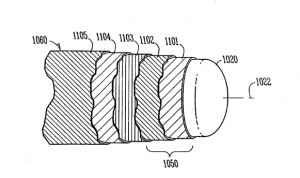Patent title: Composite Softball Bat with Inner Sleeve
Patent number: US 20040209716 A1
Patent filing date: June 18,2001
Patent issue date: October 21, 2004
How long it took for this patent to issue: 3 years
Inventor(s): Matthew Vacek, George Griffith
Assignee (if applicable): Miken Composites, LLC.
U.S. classification: 473/567
How many claims: 40
If you have ever participated in little league baseball or softball you can probably vividly remember the pain of batting practice on a cold morning and the sting of your hands with every hit. With the traditional aluminum or wooden bats you most likely used, the sting from the vibration was something players came to expect. Today’s players, however, may never know the real extent of this pain with the introduction of composite bats. In short, this invention makes softball bats more energy efficient, enhancing their performance as well as comfort for the player using it.
Previously, metal bats were the most common bat. Compared to the wooden bats used before, metal bats were much more durable. Unlike wood, metal bats did not snap in half, but almost every hit left a dent of some size on the bat. Mechanically speaking, the bat is an accessory the player uses to transfer energy from their arms to the ball during their swing. The energy that is used to dent the bat, therefore, is energy lost from the actual hit and counterproductive for the player. Even if the dent is not visible, metal bats experienced microscopic cracks that ultimately failed due to shock loading. Surprisingly to me, metal bats failed after as few as twenty-five hits. That means that a brand new bat could fail in during warm-up and already be past it’s prime by game time. Patent US 20020198071 A1 proposed a composite bat where the inner reinforcement sleeve was aluminum, and was the biggest driver for this upgraded patent.
Figure A. An inside look at the multi-layer construction of the ultimately hollow bat barrel.
Of the 40 claims included, most are focused on the manufacturing of the bat-the molding of the inner sleeve and fusing of the handle- however, the composite material used is what makes it novel. US Classification 473/567 represents designs “of plastic compilation” which is the greatest improvement on already existing bats. The design of the bat, as shown in Figure A, is tubular “sleeves” concentrically aligned and the ultimately hollow barrel. Unlike the previously proposed “composite bats” this was the first completely composite design. The bat is “comprised of a continuous resin matrix reinforced with a plurality of circumferentially-extending fiber socks”. The fiber socks are comprised of, by weight, 74% fiberglass and 26% carbon fiber and enforced with nylon tapes. This design provides the ultimate level of strength with the added benefit of a flexible body. This elasticity of the barrel provides a “trampoline effect” where the bat acts as a springboard for the ball. The local deformation when the bat is in contact with the ball ultimately results in the maximum velocity of the ball by conserving energy rather than stealing it with a dent. The composite material allows the barrel to momentarily elastically deform into an oval and return to a perfect circle rather than denting and being permanently harmed.
This design will excite softball player across the globe. Unlike in baseball, softball players from age 5 to professional, are allowed to use metal or composite bats. Additionally, this design will benefit all players, not just the elite. In softball terminology, the composite material and construction of the barrel elongates the sweet spot that we all aim to find as a batter. As a smaller-framed softball player, I found this technology exceptionally interesting since anyway to enhance the power of my swing is greatly appreciated.




I knew metal bats weren’t allowed in MLB due to safety precautions; in fact, my research advisor at the University of Michigan, Dr. James A. Ashton-Miller, served on an NCAA panel regarding this topic. But I had no idea that they were allowed in softball. Do know if this technology is currently used in commercially available bats? Do you think it gives an unfair advantage to users?